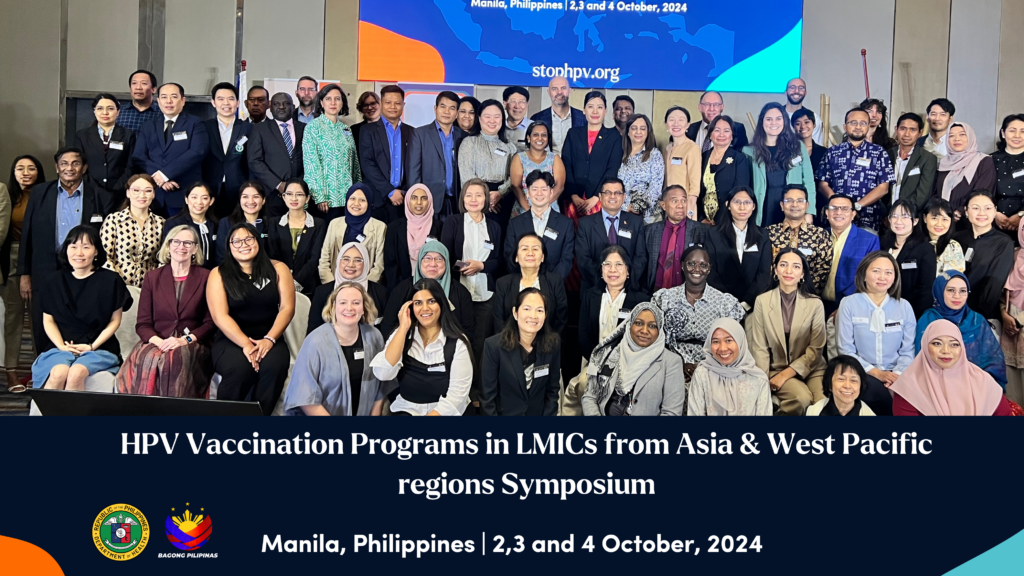
The HPV Vaccination Programs in LMICs from Asia & Western Pacific regions Symposium took place in Manila on the 2,3 and 4th of October, marking the fourth event of symposia series aimed at strengthening HPV vaccination community. Previous symposiums were held in Addis Ababa (covering Eastern Africa region), Delhi (covering South Asian region), and Abidjan (covering West African region). The Asia & Western Pacific regions focused symposium brought together 95 participants from 17 countries across the region, representing civil society organizations, Ministries of Health and Education, NGOs, NITAG members, and EPI managers. Key global partners such as WHO, UNICEF, Gavi, JSI, and PATH also participated. The symposium was organized by the Coalition for Strengthening HPV Immunization Community (CHIC), a collaborative initiative led by the Centre for the Evaluation of Vaccination (CEV) at the University of Antwerp, Jhpiego, and the Vaccine Confidence Project (VCP) at the London School of Hygiene & Tropical Medicine, in partnership with the Ministry of Health from the Philippines. CHIC works to accelerate the introduction and scale-up of HPV vaccination in LMICs.
The Western Pacific region bears 30% of the global cervical cancer burden, and while 80% of countries in the region have introduced HPV vaccination, significant challenges remain in reaching the target of 90% coverage for cervical cancer elimination. Similarly, in Southeast Asia, cervical cancer is the second most common cancer, and although seven countries have introduced the vaccine, issues such as vaccine supply constraints, high costs, and weak delivery systems continue to impede progress. To address these gaps, countries are conducting catch-up vaccination campaigns and working to strengthen school-based vaccination programs.
Participants engaged in discussions focused on HPV vaccine coverage, program sustainability, and overcoming barriers to vaccination, with particular attention to reaching hard-to-reach populations and integrating HPV vaccines into routine health services. One of the key activities involved each country preparing a country snapshot outlining key information about their respective HPV vaccination programs, now available on the CHIC website.
During the interactive working group sessions, participants discussed key challenges in their HPV programs and participated in peer-to-peer learning. Each country group then identified key actions to improve their programs. Common strategies included improving outreach to out-of-school girls through multisectoral collaboration, enhancing monitoring and evaluation systems, and integrating HPV vaccination into routine health services. Some countries are focusing on catch-up campaigns for missed cohorts, while others are exploring cross-sector collaboration and innovative solutions such as self-administration of vaccines.
Moving forward, the CHIC project is preparing a comprehensive summary and manuscript on the findings from the symposium, as well as producing an advocacy highlight video that captures key moments from the event. A series of interviews with key-stakeholders from the region was conducted with the aim of producing short country snapshot advocacy material, to further engage the community of practice in the region and globally. To maintain engagement and assess country progress, we will hold a post-symposium follow-up activity in the first half of next year.
The Asia & Western Pacific regions symposium, held in Manila, provided an invaluable opportunity for collaboration and knowledge exchange among key stakeholders from Asia and the Western Pacific. Through interactive discussions and peer-to-peer learning, participants identified actionable steps to strengthen their HPV vaccination programs. As countries work toward achieving 90% coverage and eliminating cervical cancer, continued efforts and global support will be essential. The next steps outlined in this symposium will help sustain momentum, foster deeper collaboration, and ensure that every girl has access to life-saving HPV vaccines.